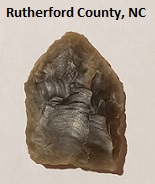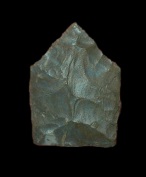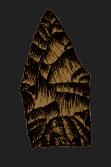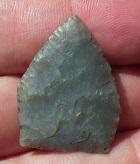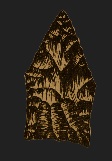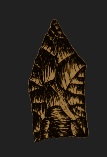Outline is Representative of Size and Shape: 
Name Details:
Identified By: Joffre Coe
Named For:
Date Identified: 1964
Type Site: Doerschuk Site, Montgomery County, North Carolina
Identified By: Joffre Coe
Named For:
Date Identified: 1964
Type Site: Doerschuk Site, Montgomery County, North Carolina
Point Validity:
Valid type
Coe was a highly respected and pioneering anthropologist in North Carolina archaeology and a preeminent authority on eastern North American anthropology. This type was named in a professional publication and has many professional references. This is considered a valid type.
Pee Dee Pentagonal
AKA: Jack's Reef PentagonalCluster: Mississippian Pentagonal Cluster
Description of Physical Characteristics and Flaking Pattern:
This is a thin small to medium (.5 to .75 inches) asymmetrical pentagonal point with a flattened cross section. The blade is broad and may vary from straight to excurvate from the point to the hafting region. The hafting area may vary from straight to contracting giving the point a pentagonal shape. The blade may vary from symmetrical to asymmetrical. The base is most commonly straight, but some examples have had concave bases. This point has a random flaking pattern.
Size Measurements:
Total Length - 25 to 61 mm (42 mm average), Length of Hafting Area - 12 to 28 mm (20 mm average), Width - 24 to 21 mm (23 mm average), Thickness - 3 to 8 mm
Total Length - 25 to 61 mm (42 mm average), Length of Hafting Area - 12 to 28 mm (20 mm average), Width - 24 to 21 mm (23 mm average), Thickness - 3 to 8 mm
Commonly Utilized Material:
Additional Comments:
The Jack's Reef Pentagonal and the Pee Dee are thought to represent the same point. This point is called Jack's Reef Pentagonal in the Northeast and into the Ohio and Tennessee river basin's. It is called Pee-Dee in Virginia and into the Carolina's (W10). This point has been called the Mississippi Pentagonal point (Cambron, 1975).
This point is similar in form to the Jack's Reef Corner Notch, but lacks the hafting element. This point has been thought to be a preform for the Jack's Reef Corner Notch, but these points also served as finished tools and points (Justice, 1987).
Lowe (2013) suggest that these points originated on the Atlantic Coast and then spread westward.
Earlier examples are thicker and slightly cruder than later examples (W11).
The Jack's Reef Pentagonal and the Pee Dee are thought to represent the same point. This point is called Jack's Reef Pentagonal in the Northeast and into the Ohio and Tennessee river basin's. It is called Pee-Dee in Virginia and into the Carolina's (W10). This point has been called the Mississippi Pentagonal point (Cambron, 1975).
This point is similar in form to the Jack's Reef Corner Notch, but lacks the hafting element. This point has been thought to be a preform for the Jack's Reef Corner Notch, but these points also served as finished tools and points (Justice, 1987).
Lowe (2013) suggest that these points originated on the Atlantic Coast and then spread westward.
Earlier examples are thicker and slightly cruder than later examples (W11).
Distribution:

Distribution Comments:
This point is primarily associated with the Piedmont of Virginia and North Carolina (red). This point is thought to be the same as the Jack's Reef Pentagonal point which has a distribution as seen in yellow. Green represents the distribution of the South Appalachian Pentagonal.
This point is primarily associated with the Piedmont of Virginia and North Carolina (red). This point is thought to be the same as the Jack's Reef Pentagonal point which has a distribution as seen in yellow. Green represents the distribution of the South Appalachian Pentagonal.
Age / Periods:
Date: 1,500 - 1,000 B.P.
Cultural Period: Woodland
Glacial Period: Roman to Medieval Warm
Culture: Point Peninsula Culture
Date: 1,500 - 1,000 B.P.
Cultural Period: Woodland
Glacial Period: Roman to Medieval Warm
Culture: Point Peninsula Culture
Similar Points:
Caraway, Levanna, Madison, Mouse Creek, Pee Dee, South Appalachian Pentagonal, Susquehannock Triangle
Caraway, Levanna, Madison, Mouse Creek, Pee Dee, South Appalachian Pentagonal, Susquehannock Triangle
Other points in this cluster / Related / Associated Points:

